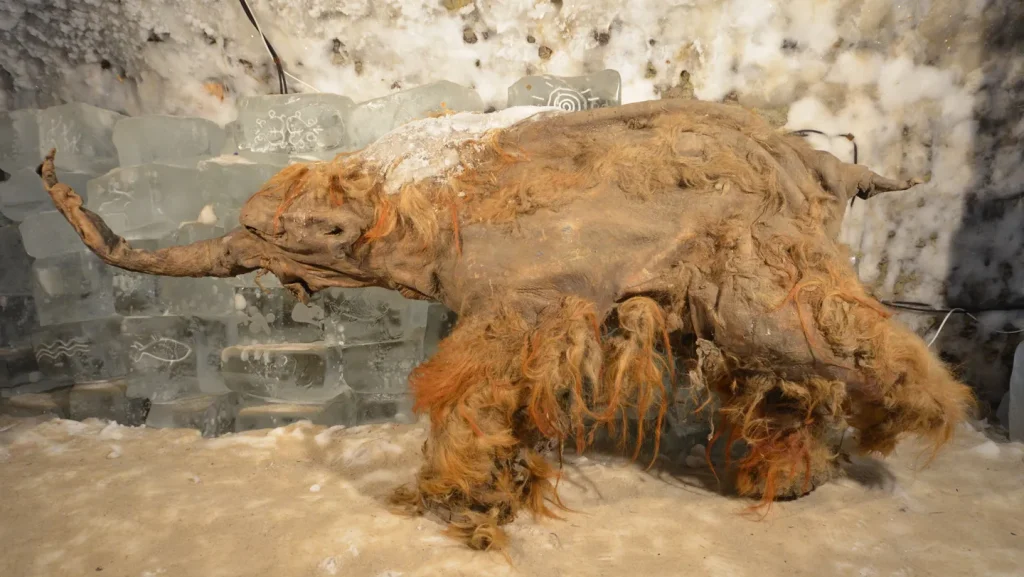Ancient Mammoth RNA Reveals Insights from the Ice Age
The discovery of Yuka, a remarkably preserved woolly mammoth found in Siberian permafrost, has opened an extraordinary window into Earth’s prehistoric past. This 40,000-year-old juvenile mammoth, with her strawberry-blonde coat still intact, represents one of the most complete mammoth specimens ever recovered. While ancient DNA studies have become increasingly common in paleontology, scientists recently achieved something previously thought impossible – the recovery and analysis of RNA (ribonucleic acid) from Yuka’s remains. This breakthrough marks a significant advance in our understanding of extinct species, as RNA provides different and complementary information to DNA, offering glimpses into the actual biological activity that occurred in Yuka’s cells thousands of years ago.
Unlike DNA, which primarily stores genetic information, RNA actively participates in gene expression and protein synthesis – essentially transforming genetic instructions into living tissue. RNA is generally considered far more fragile than DNA, breaking down rapidly after death, which makes this discovery particularly remarkable. The preserved RNA from Yuka’s liver tissue revealed thousands of transcripts – the RNA messages that cells use to build proteins and regulate biological processes. By comparing these ancient transcripts with those from modern elephants, Yuka’s closest living relatives, researchers could identify which genes were active in the mammoth’s cells at the time of death. This molecular time capsule offers unprecedented insights into how woolly mammoths functioned physiologically and adapted to their harsh Ice Age environment.
Yuka’s story begins approximately 40,000 years ago on the ancient tundra of what is now Siberia. As a juvenile mammoth, perhaps six or seven years old, she roamed a landscape vastly different from today’s Arctic. The woolly mammoth (Mammuthus primigenius) was superbly adapted to cold environments with their thick fur, small ears to minimize heat loss, and a layer of insulating fat up to 4 inches thick. Evidence from Yuka’s RNA suggests active gene expression related to cold tolerance, immune function, and metabolism – biological processes that helped these magnificent creatures thrive in temperatures that would kill most modern mammals. The RNA analysis also revealed stress responses active in Yuka’s liver, potentially indicating her physiological state in the final moments before death or during the preservation process itself.
The preservation of Yuka’s remains represents an extraordinary confluence of events. After death, her body must have been rapidly frozen and remained entombed in permafrost for millennia, protected from the oxygen, water, and microbes that typically break down biological molecules. The continuous cold effectively created a natural deep-freeze, preserving not just Yuka’s physical appearance but also her molecular components. The scientific team analyzing Yuka’s RNA employed cutting-edge sequencing technologies and bioinformatics tools specifically adapted for degraded ancient material. These methods allowed them to distinguish genuine mammoth RNA from potential contamination by modern organisms – a critical challenge in ancient biomolecule research. The researchers’ success offers hope that similar analyses might be possible on other exceptionally preserved specimens from the permafrost, potentially including other extinct Ice Age fauna like woolly rhinoceroses or cave lions.
Beyond satisfying scientific curiosity, this research has implications for understanding extinction, evolution, and climate adaptation. Woolly mammoths disappeared from most of their range by about 10,000 years ago as the Ice Age ended, with the last population persisting on Wrangel Island until roughly 4,000 years ago. By studying Yuka’s active genes, scientists gain insights into the biological mechanisms that allowed mammoths to adapt to extreme cold – adaptations that ultimately proved insufficient as their habitat disappeared during global warming at the end of the Pleistocene. The RNA data also enhances our understanding of elephant biology and evolution, highlighting genetic pathways that have been conserved or altered over millions of years of evolution. Some researchers even suggest that understanding mammoth cold-adaptation genes could have applications in modern conservation biology or biotechnology.
The story of Yuka and her ancient RNA reminds us that the past is not as inaccessible as we once thought. Each new technological advance allows scientists to recover more information from remains once considered to have yielded all their secrets. From the permafrost of Siberia, this juvenile mammoth continues to “speak” to us across 40 millennia, her cells’ molecular activities frozen in time. As climate change now threatens the very permafrost that preserved Yuka, there is both urgency and poignancy in this research – we are learning about an ancient extinction even as many modern species face similar threats from habitat loss and climate change. Yuka’s RNA represents not just a scientific milestone but a profound connection to our planet’s history, offering lessons about adaptation, survival, and the incredible resilience and fragility of life on Earth.


